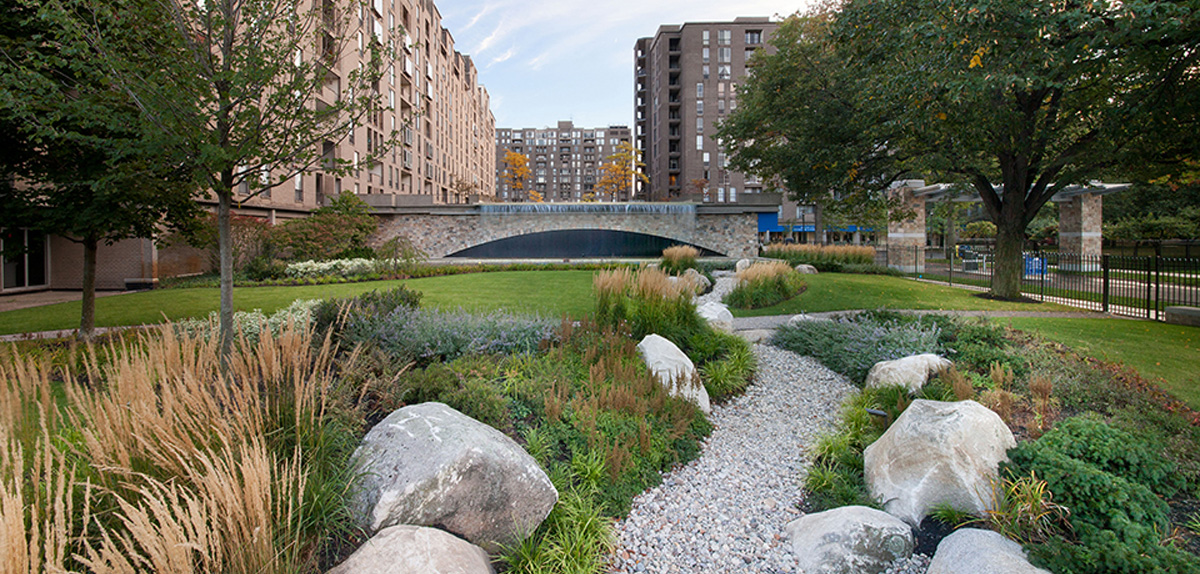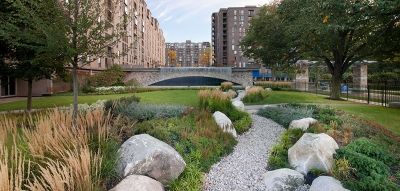
Symbio Design Blog
Using Native Plants To Create a Sustainable Design Strategy
Written by Mike WhiteUsing Native Plants To Create a Sustainable Design Strategy
April 24, 2017
Integrating native plants into your landscape is a sustainable and cost effective design strategy that provides numerous benefits to property owners. Native plants, are indigenous to a given area and have occurred there naturally over time. Because of this occurrence native plants possess unique adaptations, which enable them to better survive the conditions of their environment. In this newsletter, we will discuss the advantages and important items that you should consider when selecting your native plant palette.
Advantages of Native Plants:
- Long lifespan
- Use less water, fertilizers, and pesticides
- Adaptations to the region's soil, hydrology, and climate
- Developed natural defenses to withstand many types of
- insects and diseases
Because of these traits, native plants once established require lower maintenance costs than non-native plants.
Continuum Landscape Architects can assist property owners in developing cost-effective, low-maintenance planting strategies that add value and aesthetic appeal year after year. Below are a few key items you should consider when developing a native plant palette.
Zone in on your Hardiness Zone
When creating a design strategy for your landscape, one of your first considerations should be to determine which plants are best suited for your hardiness zone. These zones, categorized by their average annual extreme minimum temperature, are marked on plant labels, making it easy to identify. Placing a plant adapted to a warmer hardiness zone in a cooler hardiness zone can create stress for the plant, limiting growth and threatening its survival. For the continental United States, hardiness zones range from 3a to 11a; Massachusetts has a range from 5a (-20°F) to 7b (10°F). Coastal Massachusetts boasts a higher hardiness zone because the Atlantic Ocean moderates the temperature. This phenomenon creates environments where adjacent lands can support different plants. Cape Cod, Martha's Vineyard, Nantucket and other coastal towns in Massachusetts share this phenomenon, and typically experience a longer autumn, a less severe winter, and a cooler spring.
Here is a link to the USDA Plant Hardiness Zone Map.
Microclimates are a bigger deal than their name implies
Understanding the hardiness zone of your location is the first step in determining which native plants are best suited to your environment. To ensure you select the most resilient plants, you must look for any microclimates that exist on your planting site.
Microclimates can be smaller areas of a site that exhibit climatic factors that differ from the climate of the surrounding area.
Microclimates can exhibit characteristics outside of the general hardiness zone. Some features that create these microclimates are proximity to a building, pavement that can continue to radiate heat absorbed from the sun, a berm that may cause water to pool or drain, an area of pronounced shade or sun, or a wind tunnel created by nearby features.
Analyzing the Coastal influence
Familiarizing yourself with your hardiness zone and microclimates is sure to lead to a successful and sustainable landscape design. The significance of these factors is apparent when we take a closer look at Coastal Massachusetts towns as well as Cape Cod and the Islands. Coastal winds influence microclimates, and we see this particularly during the temperamental New England winter when these conditions become more pronounced. Winds from the northwest (bringing cold air from Canada and the Mid-West), inflict some of the most harm to your plants during storms. These winds also carry salt from the ocean and blanket the landscape. These salty winds can wreak havoc on plants not adapted to this unique coastal environment.
The best way to ensure a robust and resilient landscape in Coastal Massachusetts is to consider hardiness zone, microclimates, and indigenous plants. If you use this strategy, your landscape project will realize several advantages such as:
- Save on water - Native plants are accustomed to surviving on the water that comes from natural rainfall or minimal additional watering.
- Reduce the need for pesticides and fertilizers - Native plants have developed natural defenses against pests. Additionally, the use of pesticides sometimes kills off other insects that may help the native plant otherwise serve as fertilizers or promote growth.
- Require less maintenance - if you're not watering, or adding pesticides and fertilizers, then there is no labor-intensive maintenance plan to follow allowing more time to enjoy your landscape.
- Foster a healthy relationship with wildlife - Indigenous plants attract native wildlife, insects, birds, and pollinators like butterflies. They all work together to make a beautiful environment.
Sources:
Bob, Hoxie. Hoxie Landscape. 25 Jan Sebastian Dr, Sandwich, MA. Personal Interview 10 Oct. 2016.
McMoran, Don and Sacha Buller. How to Determine Your Garden Microclimate. 1st ed. Washington State University. Web. 4 Oct. 2016.
"The Polly Hill Arboretum." 809 State Rd, West Tisbury, MA. Accessed 5 Oct. 2016.
Sylvan Nursery. 1028 Horseneck Rd, Westport, MA. Retail Price List for 2016.
“United States Department of Agriculture.” About. Accessed 4 Oct. 2016
https://ag.umass.edu/home-lawn-garden/fact-sheets/usda-plant-hardiness-zone-map-changes-in-2012-edition
Investing in a modern irrigation system will increase the value of your landscape
Written by Mike WhiteInvesting in a modern irrigation system will increase the value of your landscape
Continuum Landscape Architects works with property owners and institutions to design and implement landscape improvements that achieve your goals and add value to your property. We look at the big picture to help ensure that the money you spend on your landscape will benefit you for years to come.
Conserve water, save money while maintaining a beautiful landscape
Reducing our water usage is more pressing now than ever, as many of our communities have enforced water-use restrictions due to the continuing drought, but, did you know that modern irrigation systems are efficient and economical whether or not we're experiencing drought conditions?
Investing in smart irrigation technologies saves money
Irrigation systems are the easiest and most economical way to take care of your landscape. Today, there are new technologies that significantly reduce water consumption, regardless of varied climates and levels of rainfall. That means valuable water and cost-savings for property owners. The beauty of these irrigation technologies is that they can be installed on pre-existing systems for relatively low cost and monitor drought and abundant rainfall conditions.
Whether your irrigation system is newly installed or has been utilized for years, there are ways to reduce your water consumption
Rain sensors are relatively affordable and have the ability to detect certain levels of rain and shut down the system accordingly. There are two main types of rain sensors for irrigation systems:
- Soil Moisture-Based Controllers shut off the irrigation system when moisture content in the soil exceeds pre-programmed levels. By measuring moisture in the roots, the system compares readings to recommended levels for the plant, soil type, and other programmable variables. The device is programmed to turn on and off depending on the pre-programmed moisture levels.
- Weather-Based Controllers use factors such as evapotranspiration calculations, local forecasts, soil and plant types, sun exposure, and local weather conditions to adjust the irrigation schedule automatically and ensure customized watering schedules that save both water and money. These systems enable users to control their sprinklers, monitor settings and keep track of savings right from their smartphone.
Sustaining the trend: developing more eco-friendly landscapes
Today, more and more property owners are looking for ways to join the Green Building Movement. Clients are seeking sustainable landscapes that fit their property, suit their lifestyle and are friendly to the environment. Incorporating smart irrigation into your project is one of the strategies that applies to many sustainability certification systems, including USGBC's Leadership in Energy and Design (LEED) rating system and the Sustainable Sites Initiative (SITES). Both rating systems require irrigation systems to provide proof of the intended decrease in water in order to receive points. Continuum Landscape Architects can help you implement these and many other sustainable landscape solutions.
Call us today and maximize your ROI
Whether you're thinking about resale value or you want to extend the usability and functionality of your landscape, Continuum Landscape Architects will help prioritize and develop an improvements plan that accomplishes all of your goals and meets your budget.
We look forward to working on your next project with you.
Symbio Design Offices • 617-921-4254
Boston: 1035 Cambridge Street, Suite 1, Cambridge, MA 02141
New York: 347 5th Avenue, New York, NY 10016
Home | About | Services | Portfolio | Blog | Contact | Sitemap
Site design by Dionne Katinas. Site development by Tinetrix, Inc

